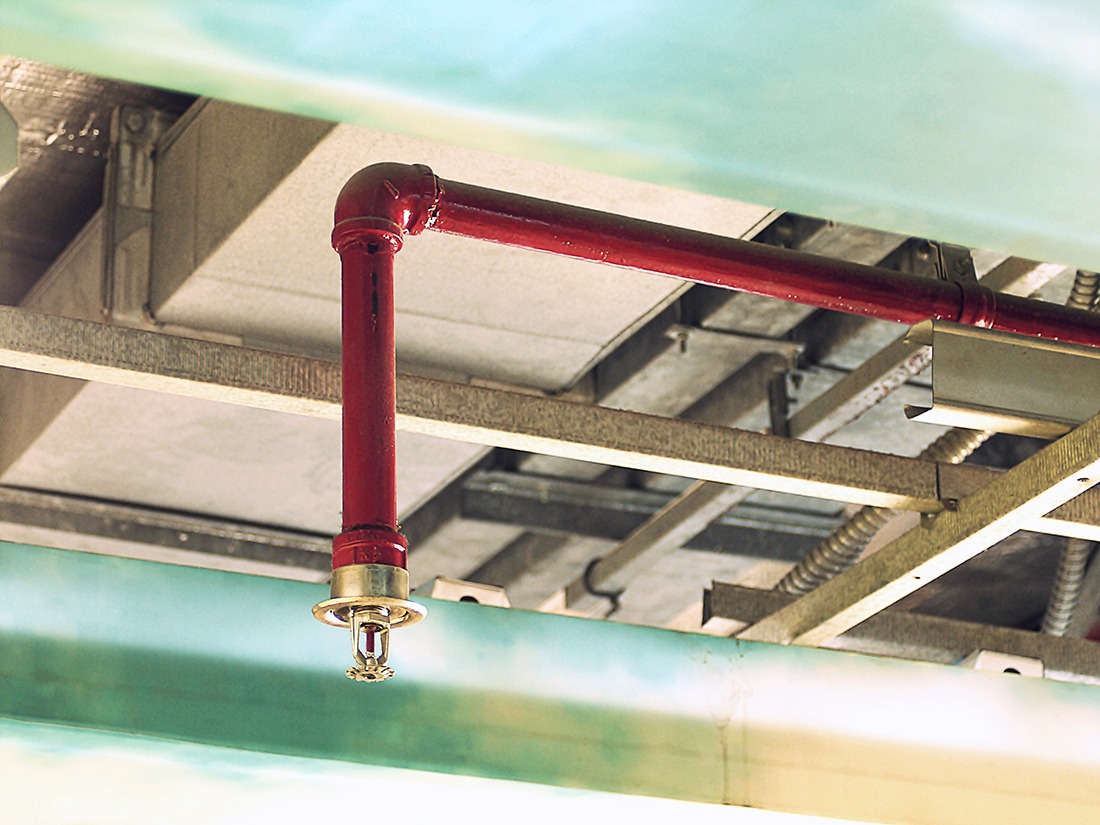Many different types of fire sprinklers have been created since the first recognised fire sprinkler system was invented in 1812 to keep up with changes in environmental systems.
There are seven main types of sprinkler systems that all help to prevent flames from spreading and reduce fire damage. The main differences between the seven types are their activation and application:
#1 Wet Pipe Fire Sprinkler System
Wet pipe systems are the most commonly used fire sprinkler systems, thanks to their simple yet reliable way of working. The pipes of a wet pipe system contain water, which is released when the fire sprinkler element reaches a specific temperature. With this system, the installed facilities must never drop below freezing, so the pipes don’t freeze.
Wet pipe systems are usually found in high-rise office buildings, schools and other commercial buildings that face common fire hazards.
#2 Dry Pipe Fire Sprinkler System
Unlike wet pipe systems, dry pipe systems are filled with pressurised air or nitrogen. Air pressure keeps the pipe valve closed and prevents water from entering the system. When a sudden temperature increase is detected, the air pressure drops, causing the dry pipe valve to open and water to flood into the sprinkler system. This water is then discharged from the activated fire sprinkler system.
Dry pipe systems are the second most popular fire sprinkler system. They are usually installed in unheated buildings such as parking garages or warehouses as they contain no water and are ideal for areas subject to freezing temperatures.
#3 Deluge Fire Sprinkler System
Unlike the other types of fire sprinkler systems, the sprinkler heads on the deluge system stay open and activate at once – making them ideal for high-risk fire hazard facilities.
No water or pressurised air is stored in a deluge fire system. Instead, the deluge valve opens when smoke or heat is detected, and water is then sent to all fire sprinklers, allowing water to be discharged from each sprinkler head.
Facilities like industrial plants, manufacturing units and aircraft hangers rely on deluge fire systems as they are the most fast-acting sprinklers. These types of premises tend to contain highly combustible material that will spread flames quickly if they catch fire.
#4 Pre-Action Fire Sprinkler System
The pre-action fire sprinkler system also contains pressurised air or nitrogen, similar to the dry pipe system. However, the difference is that it is activated through a two-step process:
- Firstly, a heat or smoke detector detects a fire, sends a signal to open the pre-action valve, and fills the system with water.
- The fire sprinkler head must then detect an increase in temperature indicative of a fire. If it does, it will open and pour water immediately onto the fire.
The aim of the two-step activation process in the pre-action system is to prevent accidental activation of the system in places where water can be catastrophic – such as libraries, museums and server rooms.
#5 Foam Water Fire Sprinkler Systems
Foam water systems are specialist systems that discharge a mixture of foam concentrate and water when activated. They are used in cases of high-challenge fires, such as those fires that are started in the presence of flammable liquids.
#6 Water Spray Fire Sprinkler Systems
Water spray systems are similar to deluge systems. They are, however, designed to safeguard a uniquely configured hazard and don’t cover all of the horizontal floor areas of space. This makes them popular for use to protect electrical transformers, for example.
#7 Water Mist Fire Sprinkler Systems
This type of system uses a heat absorbent vapour to atomise the water and turn it into a mist, making it useful for conditions where water may damage items or where there is a minimal water supply.
If you are working on any projects where you feel our fire sprinkler systems service, transforming your fire sprinkler design into 3D, may be helpful, please don’t hesitate to contact us. We will happily provide any help you need. You can call us on 0161 427 0348 or email us at office@thecadroom.com

